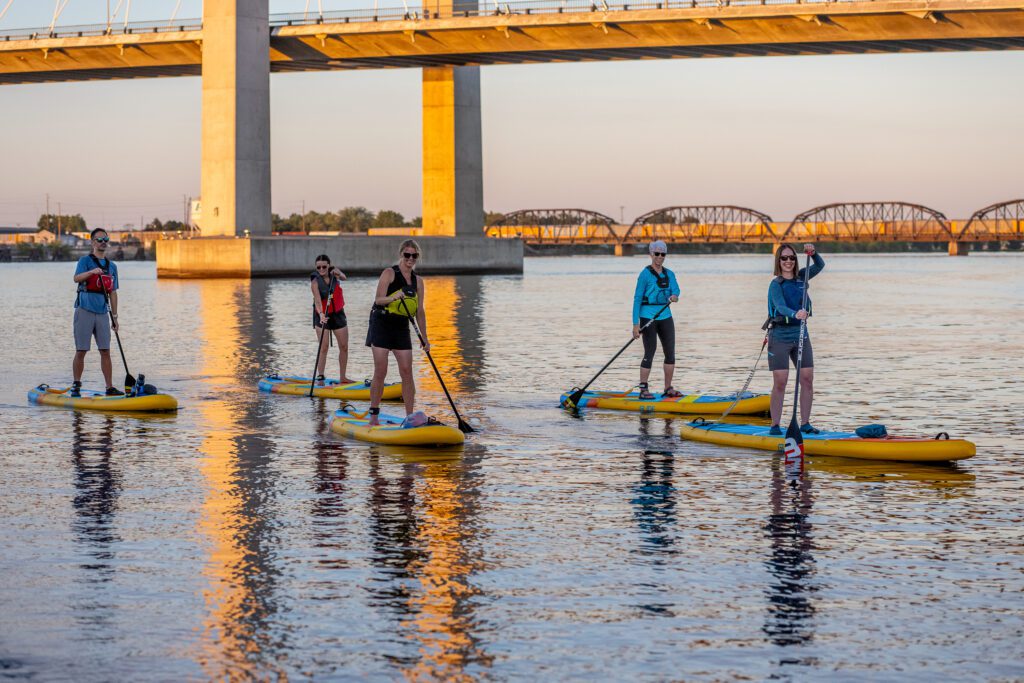Paddling with a group can be an incredible experience—whether you’re joining an organized paddle, heading out with friends, or participating in a guided tour. Group paddling not only enhances safety but also builds connection, encourages skill development, and makes for unforgettable adventures on the water. However, navigating a group paddle effectively requires some planning and awareness to ensure a smooth, safe, and enjoyable outing for everyone involved.

Here are some key tips to help you make the most of your next group paddle.
1. Communication is Key
Before you even hit the water, set clear expectations. If you’re paddling with an organized group or a mix of experience levels, discuss the following:
- Route & Distance: Know where you’re going, expected conditions, and turnaround points.
- Paddle Pace: Will the group stay together, or is it okay to spread out?
- Safety Protocols: What’s the plan if someone falls in or gets separated?
- Hand Signals or Calls: Agree on basic signals for stopping, regrouping, or hazards ahead.
Having these conversations ahead of time prevents confusion and keeps everyone on the same page.
2. Know the Right-of-Way & Group Etiquette
Just like on roads or hiking trails, there are guidelines for navigating shared waterways. When paddling in a group, keep these in mind:
- Stick to the right side of the waterway when safe and practical, as most waterways follow right-hand navigation. However, always stay aware of local regulations and conditions.
- Always yield to larger vessels—they often have limited ability to maneuver.
- Avoid sudden stops or turns without signaling to those behind you.
- If you need to stop, notify someone and move to the shore or an eddy to avoid drifting.
- When passing through narrow passages or bridges, go single file instead of bunching up.
These small considerations help keep the group moving smoothly and safely.
3. Maintain Spacing & Formation
While it’s fun to paddle close to friends, overcrowding can lead to accidents—especially in wind, waves, or boat traffic. Follow these best practices:
- Stay within talking distance to maintain connection without being too close.
- In open water, a staggered formation (rather than a straight line) allows for more visibility and flexibility.
- Assign a lead paddler to set the pace and a sweep paddler at the back to assist anyone who falls behind.
- When in areas of increased boat traffic, stay and move together as a group. A group is much easier to see than a single paddler and best for communicating, improving overall safety.
Proper spacing makes for a more relaxed and controlled group experience.
4. Be Mindful of Mixed Skill Levels
One of the biggest challenges in group paddles is ensuring that everyone, from beginners to advanced paddlers, has a great time. Here’s how to accommodate different skill levels:
- Set realistic goals for the paddle that work for the least experienced members.
- Encourage more skilled paddlers to take turns leading or offering gentle guidance.
- Have a plan for regrouping—whether it’s stopping at certain landmarks or floating together at breaks.
- Check in throughout the paddle, especially if you’re leading. A quick “How’s everyone feeling?” can go a long way in making sure no one is struggling in silence.
- Be patient. Group paddles are about the shared experience, not just speed or distance.
- Pro Tip: If there are paddlers with more experience who want to get more of a workout, you can always suggest they do laps (up and back) as the group progresses. This allows them to stay engaged while accommodating different paces.
5. Pack the Essentials & Plan for Conditions
Group paddles can last longer than solo outings, so it’s important to be prepared. Everyone should bring:
- PFD (Life Jacket): Required for safety and a must-have on all group paddles.
- Leash (quick-release): Essential for board control, especially in open water or waves.
- Whistle or Communication Device: A whistle is required by law and helps signal others in case of emergency. Carrying other communication devices, such as cell phones, VHF radios or satellite devices in dry bags, can also be helpful for larger groups or emergency situations.
- Water & Snacks: Staying hydrated and fueled is key.
- Weather & Route Awareness: Check conditions beforehand to avoid surprises.
Proper preparation ensures the group can handle changes in conditions and enjoy a stress-free paddle.
Final Thoughts: Paddle Together with Confidence
Group paddling is about more than just getting on the water together—it’s about shared adventure, safety, and connection. Whether you’re exploring a new waterway or paddling familiar routes, following these tips will help create a smooth, fun, and rewarding experience for everyone involved.
At Aqueous SUP, we believe in building a community of paddlers who not only enjoy the water but also support and look out for one another. So next time you hit the water with a group, take the time to plan, communicate, and paddle with purpose!
What’s your favorite group paddling experience? Share in the comments—we’d love to hear your stories!

